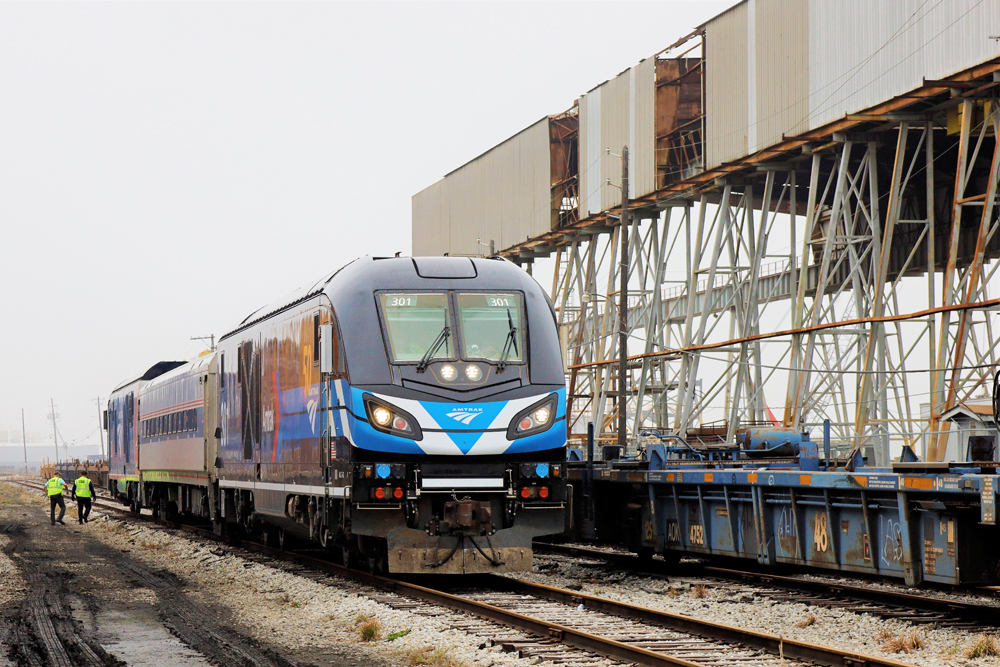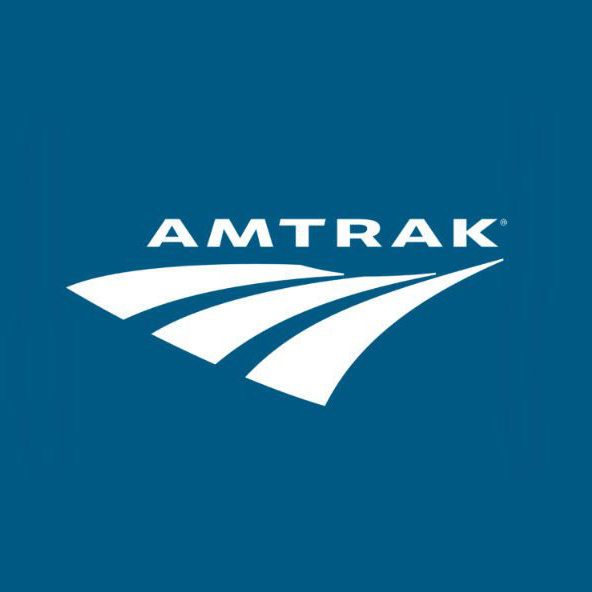 WASHINGTON — Major rail groups have applauded Friday’s passage of a major infrastructure bill by the U.S. House of Representatives which will include major funding for freight and passenger projects. The bill now goes to President Joe Biden for his signature.
WASHINGTON — Major rail groups have applauded Friday’s passage of a major infrastructure bill by the U.S. House of Representatives which will include major funding for freight and passenger projects. The bill now goes to President Joe Biden for his signature.
The $1.2 trillion bill includes $550 billion in entirely new investments, the Washington Post reports. It earmarks $66 billion for railroads, including significant funding for Amtrak in general and the Northeast Corridor in particular, as well as $39 billion for public transit.
Association of American Railroads CEO Ian Jefferies called the bill a “truly comprehensive infrastructure package,” saying, “As we continue to navigate supply chain challenges, the need for the thoughtful funding and policy solutions over the long term that this bipartisan package delivers are even more clear. Thanks to the hard work of many, our nation will make the significant, long-overdue investments we need to modernize our public infrastructure, enhance safety and support future economic growth.”
The AAR highlighted the inclusion of nearly $845 million per year for grade-crossing safety and separation projects, and more than $5 billion per year for infrastructure grant programs including the Consolidated Rail Infrastructure and Safety Improvement (CRISI) grant program supporting short lines, passenger rail, and state departments of transportation.
Chuck Baker, president of the American Short Line and Regional Railroad Association, pointed to the CRISI and grade-crossing programs, as well as the Rebuilding American Infrastructure with Sustainability and Equity (RAISE) and Infrastructure for Rebuilding America (INFRA) programs, in calling the legislation “a historic victory for the short line industry.” In a statement, Baker said short lines will “aggressively compete for and then quickly put to good use” those funds, “investing in game-changing infrastructure projects.” The legislation, he said, “artfully balances regulatory oversight without including overly burdensome and unnecessary operational mandates.”
Amtrak CEO Bill Flynn said the legislation “will allow Amtrak to advance significant infrastructure and major station projects on the [Northeast Corridor], purchase new passenger rail equipment and develop new rail corridors, bringing passenger rail to more people across the nation. As demonstrated by their commitment to rail in this bill, the Administration and Congress believe in the future of rail and Amtrak and we will move quickly to advance these projects.” Amtrak board chair Tony Coscia said the bill “provides historic levels of investment for intercity passenger rail in this country and the start of a whole new era for improved and expanded Amtrak service. … We look forward to working with Secretary Buttigieg, our state, commuter and host railroad partners, and communities across America to rebuild and improve the Northeast Corridor and launch the next generation of Amtrak service in cities and towns across America.”
Paul P. Skoutelas, CEO of the American Public Transportation Association, said the legislation “is vital to building the American infrastructure of the future.
“The $107 billion for public transit and $102 billion for commuter rail, Amtrak, and other high-performance rail in this bill will build infrastructure that will make public transportation faster, more modern, and more reliable,” Skoutelas said in a statement, “while tackling climate change, advancing equity issues, and providing growing communities sustainable mobility options.”














Bizarre. The railroads applauding their continued descent into government slavery. How INCREDIBLY short-sighted.
Hey Republicans…Remind me what projects got funded during Trump’s Infrastructure Week? Oh and how much did he propose funding Amtrak at each year?
This is the most transformative bill ever for Amtrak and mass transit. Take your blinders off and rejoice as new routes appear, Amfleet, Genesis and Superliners finally get replaced and ancient bridges, stations and tunnels get some long overdue attention.
Nice to see some spending at home instead of in Afghanistan. And please stop crowing about the deficit when that was a total nonissue when it was time for tax breaks for the wealthy and you oppose all efforts to better fund the IRS and close current loopholes to increase revenues.
No more pork in this than there is in the agriculture or military funding bills. You say social engineering they said that in my area when they wanted the first light rail line yet the freeways were the biggest social engineering projects ever. People use to work, live, shop & socialize in their own neighborhoods the freeways destroyed this way of life & created the sprawl of suburbs primarily to make certain people/industries rich. This fragmented & isolated people creating out current xenophobic society. The freeways did displace & isolate minority communities. In St. Paul MN I-94 went right through the center of the African American Rondo neighborhood yet the wealthy Prospect Pk area was spared with a huge bend in I 94 near to this day near the Mississippi river.
Such Republican rubbish
Hey folks – As long as America is circling the bottom of the toilet with debt and money printing, and no one gets along with anyone else any more, we may as well all go to hell in a sleeping car, with a full diner and lounge on the train.
Porkulous on steroids. This is how implementation of these spending bills work based upon my experience receiving government stimulus grants.
1. Government agencies shave off 10%, so $120 billion gone. Now only $1.08 trillion left.
2. State agencies take 10% off, so $108 billion gone. Now only $900 billion left.
3. Non-infrastructure pet projects already set to receive funding take another $800 billion. Now only $100 billion left.
4. Highway projects take another $600 million. Now only $400 million left.
5. Pet rail projects already set to receive funding take another $300 million. Now only $100 million left.
6. Worthy projects fight over the left over $100 million in pork scraps.
7. Not a whole heck of a lot gets done.
8. (Sarcasm button on.) Representatives can now say, “See, I brought home the bacon for you! Please re-elect me!”
Please keep in mind that projects receiving federal funds are required to pay Davis-Bacon prevailing wage rates and require MBE/DBE/WBE/VBE participation rates. While not bad on the surface, these federal requirements reduce project purchasing power by about 20% and add about 10% percent to the project overhead.
We were having a depression, then FDR made it great with this kind of junk.
I recently went from Bensalem,PA to Hackensack, NJ for dinner. I watched some trains on the NEC that morning, but drove on the NJTP that evening. Unless you live and/or work very close to the tracks, driving is almost always more time-efficient.
I can’t even make Amtrak work for trips north, and I live in Florida. It doesn’t miss by just a little where slightly more funding would close the gap; it misses by miles. BTW, Uber beat SEPTA for a one-time trip—too risky.
The freight rail industry has ORs in the 60s. They can buy their own stuff.
John J. Kneiling, save us.
If this really were an infrastructure bill, as opposed to what it really is, a Christmas Tree of entitlements and social engineering, then I’d support it.
Which entitlements are you talking about? I know there are many in the Build Back Better Bill but that was not passed this weekend.
Infrastructure has always included social engineering– just ask all the minorities who were displaced or further segregated in Chicago with the building of the Dan Ryan Expressway or numerous other cities, combined with racial restrictions on Fed Govt guarantees on home loans.
Jacob – Yup, same old stuff, endlessly repeated, which makes it true. Not.
In an edition of the Milwaukee newspaper, a black activist was interviewed. He claimed that 50% of the homes taken for the freeways in Milwaukee were from black families. The reporter did not challenge his claim. While I’m not that intimately familiar with Milwaukee, I have to wonder how a city 5% to 10% black at the time the freeways took out half black neighborhoods. The activist also claimed that the proposed widening of IH 94 East-West would negatively affect black neighborhoods – but he didn’t say how. Mostly it goes through non-residential areas – and those few neighborhoods it will minimally impact are not particularly African – American.
I’m much more familiar with Detroit, including virtually every neighborhood and the entire freeway system. With great frequency the claim is made – unchallenged – that the freeway system was aimed at black neighborhoods – a claim that is manifestly false, not the least shred of truth. At the time the freeway were built, freeways which cover the entire city, Detroit was a mostly white city.
Large portions of the Walter P. Chrysler, maybe some parts of the west Edsel B. Ford, the Downriver segment of the Fischer, and much of Jeffries, were built in black neighborhoods. That’s it. Most of the freeways were built in white neighborhoods (at that time) including all of the John C. Lodge, all of the Southfield, the east Edsel B. Ford, most of the Fischer, and the western end of the Edsel B. Ford toward the Dearborn city line, were white. The northern reaches of the Walter P. Chrysler, from Six Mile to Eight Mile, was entirely white.
Also, Jacob, I might point out that freeways also go into the suburbs. I never understood how black activists in Detroit could simultaneously criticize the suburbs for being all white, while overlooking the manifest fact that white homes were taken for the freeways.
Interesting. Just because it was not true in Detroit, it was true in many cities including places I have lived. Also the folks in white communities could more easily escape to suburbs which the highways made more feasible; redlining, deed restrictions and FHA loan guarantee restrictions discriminating against AA definitely occurred.
Amen to that.
Mr. Landy, you can kindly take your comments to the likes of Randall O’Toole. Some of us truly want this transformative investment in our country and infrastructure.